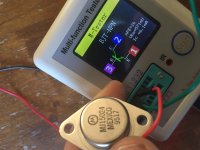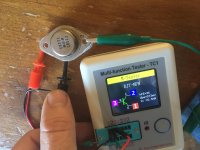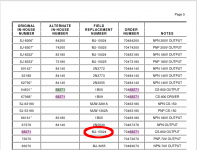This unit has -81 0 81 VDC rails and NPN only TO-3 transistors.
The factory transistors are SJ6343B by Motorola on one channel (this channel has likely been replaced with a newer factory board at some point) and RCA 68271.
I'm guessing these are proprietary Peavey transistors that are similar to something existing. Is there a suggestion that would work for this old amp? I have two shorted transistors on one of the channels.
The factory transistors are SJ6343B by Motorola on one channel (this channel has likely been replaced with a newer factory board at some point) and RCA 68271.
I'm guessing these are proprietary Peavey transistors that are similar to something existing. Is there a suggestion that would work for this old amp? I have two shorted transistors on one of the channels.
One of the six in each bank is a driver, the other 5 are outputs. Different SJ number. Ok to leave the original drivers if they’re good. MJ15024 will also work as a driver if needed. Don’t just change out the bad outputs - all 5 in any bank should be changed out together. The MJ15024 didn’t exist when this amp was made - original Moto outputs were a selected 2N3773, which is different enough from a 15024 that you don’t want to mix them. It’s safe to leave one bank all original, with one bank all new, but not preferred. Even modern 2N3773s are different enough where you wouldn’t want to mix with the old house numbers.
Also for best current sharing, the 5 output transistors should be matched. Transistors bought from Peavey will be matched: distributor sold transistors will not. At least measure Vbe on 7 or 8 same date transistors, and use the 5 with the closest matching number. I measured gain 10 Vce on my candidates after 30 seconds on a heat sink. 10 ohm collector resistor, 100 ohm base resistor. 12 v supply.
Thanks for the great advice! So if I were to just randomly throw in a pair of genuine MJ15024 transistors, would I stand a good chance of them popping again?
You would end up popping whichever type hogs more current. If the old ones tended to hog current, you would end up popping them instead of the new ones. Depends on the differences in vbe vs. Ic between the different types. Also, if some burnt out the others may have been stressed close to burn out and it might not take much to do it next time. That’s a separate issue from the matching.
Sounds like Indianajo has good advice on matching. I ordered two Motorolas. Probably not likely that they'll match what I have here now. I'd like to avoid to ordering 30 transistors to get 10 that match well enough to run safely together.
Just order the 5 (or 10) you need *at the same time*, from authorized distributors who stock and sell large quantities of them, to get units from the same production run. Getting a couple extra gives you the ability to down select further. You don’t have to order 30 unless you’re re-transisoring the entire amplifier. If you blew one in each bank, you would need *5*. You can move a working SJ6343 from one bank to the other and re-populate one with new parts.
What “Motorolas” did you order? Are they ON Semi, or something else? “Motorola” hasn’t made power transistors in 20 years…..
What “Motorolas” did you order? Are they ON Semi, or something else? “Motorola” hasn’t made power transistors in 20 years…..
These Motorolas are from a USA based ebay seller selling (supposedly) NOS transistors. The guy seems honest after contacting him but as always you never know.
I measured hFE using a TC1 "Multi-function Tester" and I get a wide range of values from the transistors currently in the amp (Peavey originals) to the replacements I just received.
Here are some numbers:
original RCA #1 - hFE = 96
original RCA #2 - hFE = 72
NEW Moto #1 - hFE = 31
NEW Moto #2 - hFE = 26
I measured hFE using a TC1 "Multi-function Tester" and I get a wide range of values from the transistors currently in the amp (Peavey originals) to the replacements I just received.
Here are some numbers:
original RCA #1 - hFE = 96
original RCA #2 - hFE = 72
NEW Moto #1 - hFE = 31
NEW Moto #2 - hFE = 26
IF your transistors are labelled Motorola they are fakes, period.
I don´t believe NOS claims from EBay sellers, period.
IF he had real ones,why take the EBay route and sell them for peanuts?
He could very well sell them inside a Forum such as DIYA and get a fortune instead.
I don´t believe NOS claims from EBay sellers, period.
IF he had real ones,why take the EBay route and sell them for peanuts?
He could very well sell them inside a Forum such as DIYA and get a fortune instead.
Last edited:
Whether or not to believe them to be NOS depends on whether they look like NOS or not. What type number? Original PV house number in aluminum case, or an “MJ15024”? NOS MJ15024 *are* readily identifiable, and you *can* test Cbe and determine if they are real.
And which RCA in the other channel? Just curious, there were several.
And which RCA in the other channel? Just curious, there were several.
Here is the NOS (or maybe "NOS"??) Motorola
Attachments
Last edited:
Those are the proper markings, and date code is consistent with Motorola before ON was spun off. They could be real, but no guarantee. I would test capacitance, and SOA (if possible).
Fakes would usually be marked with a much later date code. The problem wasn’t as widespread back in 95. You could also do the acetone test - the markings on fakes will usually come off. Especially the earlier ones before they got wise to people testing them with nail polish remover.
If they turn out to be real, I would buy the other three you really need. I would not trust putting those in parallel with late-70’s era 2N3773’s. If nothing else, the transient thermal rise profile is significantly different between the steel case with the internal copper heat spreader and the aluminum case. That will give you differences in vbe under load, emitter resistors or no emitter resistors, even with identical transistor dies (which they are not).
Fakes would usually be marked with a much later date code. The problem wasn’t as widespread back in 95. You could also do the acetone test - the markings on fakes will usually come off. Especially the earlier ones before they got wise to people testing them with nail polish remover.
If they turn out to be real, I would buy the other three you really need. I would not trust putting those in parallel with late-70’s era 2N3773’s. If nothing else, the transient thermal rise profile is significantly different between the steel case with the internal copper heat spreader and the aluminum case. That will give you differences in vbe under load, emitter resistors or no emitter resistors, even with identical transistor dies (which they are not).
The Motorola replacements I've obtained are close to the original RCAs (Vbe within 1mV). Still not a good idea to just drop them in I assume?
What type are the RCA’s, and what date code? There are several possibilities as to what they could be. Hometaxial OR epitaxial 2N3773. 2N6259 (only came in hometaxial). RCA’s own version of the 15024 (epitaxial like Motorola). RCA1B05 (triple diffused). In any case, probably some 5 digit house number that you might be able to find in PV’s cross reference. RCA only came in steel case, so the thermals might match. But mix/matching technology is not usually a good idea even if vbe matches at some arbitrarily low current - it won’t at high current. The manual says “do not mix” for a reason.
If they *are* RCA MJ15024 (wouldn’t be originals, would only have been replacements) and vbe matches within a few mV you could drop them in. They would be as close as any two 15024’s from the early 80’s were.
If they *are* RCA MJ15024 (wouldn’t be originals, would only have been replacements) and vbe matches within a few mV you could drop them in. They would be as close as any two 15024’s from the early 80’s were.
RCA units from 1985 - those would *not* be originals, might have been replacements from an authorized PV service house. The task would be to find out what the “68271” was. It had to be an epitaxial type - that’s the only thing RCA was still making in 85. It was either a MJ15024 or 2N3773. The PV cross reference would tell you - one exists *somewhere*. It’s not on this computer or the other one that’s in front of me at the moment. Somebody posted it around here somewhere (search may uncover it).
Excellent! That's what I see here also. Looks like the RCAs may??? be original part numbers. I don't know the accuracy of this cross reference (attached).
Taken from here:
https://www.audiolabga.com/pdf/PV_Semi_Cross_Ref.pdf
Taken from here:
https://www.audiolabga.com/pdf/PV_Semi_Cross_Ref.pdf
Attachments
- Home
- Amplifiers
- Solid State
- Replacement Peavey CS-800 Power Transistors?


